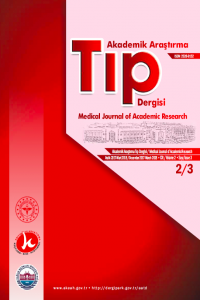Pediatrik Yaş Grubunda Acil Serviste 1 Yılda Tespit Edilen Ekstremite Kırıklarının Etiyoloji ve Epidemiyolojisi: 1878 Çocuk İle Çalışma
Çocuk, kırık, epidemiyoloji, insidans
The Etiology And Epidemiology Of Fractures In Children Presenting To The Emergency Room In One Year: Study With 1878 Patients
fracture, epidemiology, incidence, chil,
___
- 1. Cheng J.C., Shen W.Y. Limb fracture pattern in different pediatric age groups: a study of 3,350 children. J Orthop Trauma. 1993;7:15–22.
- 2. Reed MH. Fractures and dislocations of the extremities in children. J Trauma 1977;17:351¬4.
- 3. Laffoy M. Childhood accidents at home. Irish Med J 1997; 90: 26-27.
- 4. Nathorst Westfelt JA. Environmental factors in childhood accidents. A prospective study in Göteborg, Sweden. Acta Paediatr Scand Suppl. 1982;291:1–75.
- 5. Landin L A. Fracture patterns in children: analysis of 8,682 fractures with special reference to incidence, etiology and secular changes. Acta Orthop Scand (Suppl 202) 1983; 54: 1-95.
- 6. Wareham K., Johansen A., Stone M. D., Saunders J., Jones S., Lyons R. A. Seasonal variation in the incidence of wrist and forearm fractures, and its consequences. Injury. 2003;34:219–222.
- 7. Hedström EM, Svensson O, Bergström U, Michno P. Epidemiology of fractures in children and adolescents. Acta Orthop Scand 2010;81:148-53.
- 8. Cooper C, Dennison EM, Leufkens HGM, Bishop N, vanStaa TP. Epidemiology of childhood fractures in Britain: a study using the general practice research database. J Bone Miner Res 2004;19:1976-81.
- 9. Schalamon J, Dampf S, Singer G, et al. Evaluation of fractures in children and adolescents in a level 1 trauma center in Austria. J Trauma 2011;71:19-25.
- 10. Tiderius CJ, Landin L, Duppe H. Decreasing incidence of fractures in children: an epidemiological analysis of 1,673 fractures in Malmo, Sweden, 1993-1994. Acta Orthop Scand 1999;70:622-6.
- 11. Masterson E, Borton D, O’Brien T. Victims of our climates. Injury 1993;24:247-8.
- 12. Atay T, Tomruk Ö, Çetin GN, Baydar ML, Seçkin H. Süleyman Demirel Üniversitesi Tıp Fakültesi acil servisine başvuran çocuk kırıklarının epidemiyolojik değerlendirmesi. Kocatepe Tıp Dergisi 2008;9:17-21.
- 13. Rennie L, Court-Brown CM, Mok JY, Beattie TF. The epidemiology of fractures in children. Injury 2007;38:913-22.
- 14. Kalenderer Ö, Gürcü T, Reisoğlu A, Ağuş H. Acil servise kırık nedeniyle başvuran çocuk hastalarda kırıkların sıklık ve dağılımı. Acta Orthop Traumatol Turc 2006;40:384-7.
- 15. Bailey DA, Wedge JH, McCulloch RG, Martin AD, Bernhardson SC. Epidemiology of fractures of the distal end of the radius in children as associated with growth. J Bone Joint Surg [Am] 1989;71:1225-31.
- 16. Hagino H, Yamamoto K, Teshima R, Kishimoto H, Nakamura T. Fracture incidence and bone mineral density of the distal radius in Japanese children. Arch Orthop Trauma Surg 1990; 109:262-4.
- 17. Ma D, Jones G. The association between bone mineral density, metacarpal morphometry, and upper limb fractures in children: a population-based case-control study. J Clin Endocrinol Metab 2003;88:1486-91.
- ISSN: 2528-9152
- Başlangıç: 2016
- Yayıncı: Keçiören Eğitim ve Araştırma Hastanesi
Nonmetastik Testis Tümörleri Patoloji Sonuçlarımız: Klinik Tecrübemiz Ve Literatür İncelemesi
Selçuk SARIKAYA, Rıdvan ÖZBEK, Görkem GÜVENİR, Çağrı ŞENOCAK, Gülçin GÜLER ŞİMŞEK, Ömer Faruk BOZKURT
Abdominal Aorta Anatomik Varyasyonları
Özlem GÜNGÖR, Ömer Faruk GÜLER, Cansu ÖZTÜRK, Selma UYSAL RAMADAN
Primer Üretral Malign Melanom: Olgu Sunumu
Selçuk SARIKAYA, Erman DAMAR, Rıdvan ÖZBEK, İsmail SELVİ, Mehmet ÇİFTÇİ, Gülçin Güler ŞİMŞEK, Ömer Faruk BOZKURT, Öztuğ ADSAN
Aslı ÇELEBİ TAYFUR, Birgül BAYOĞLU, Banu ANLAR
A.safa TARĞAL, Bahtiyar HABERAL, Hakan ŞEŞEN, İsmail DEMİRKALE, Ahmet ATEŞ, Murat ALTAY
